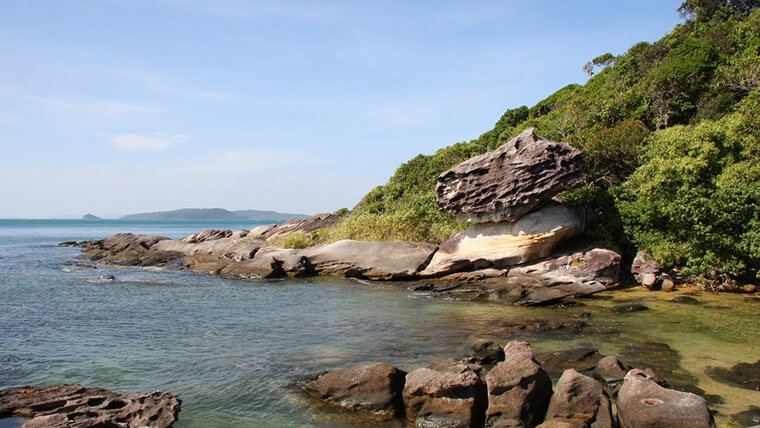For those who have no information about this famous historic relic, Phu Quoc prison Vietnam, used to be named Phu Quoc coconut prison, Phu Quoc Prisoners Of War Camp or Phu Quoc Communist Prisoners Camp is one of the most notorious detention camps in Vietnam. In 1995, it was recognized by the Ministry of Culture, Sports and Tourism as a national relic. Currently, it is a historical site and an impressive tourist attraction in the stunning Phu Quoc Island.
I - Phu Quoc prison history
1 - During the wars against French Colonists
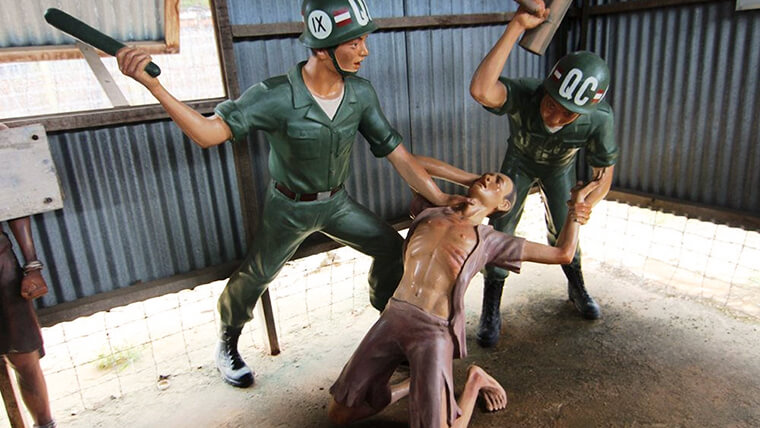
A form of torture - Source: baotainguyenmoitruong
In September 1946, the French came back to occupy Phu Quoc and decided to found the biggest prison in Southeast Asia at that time here to capture political prisoners, revolutionary soldiers and ordinary people who were against them. The reason Phu Quoc island was chosen as the location of the jail was that it had a strategic military position, far away from mainland, out of the reach of new agencies, easier for their oppression. In the middle of 1953, a goal with an area of 40 hectare was constructed in a village called Cay Dua (Coconut Tree) and named after the where it was located. The vast land in rectangle shape was divided into 4 camps: A, B, C and D.
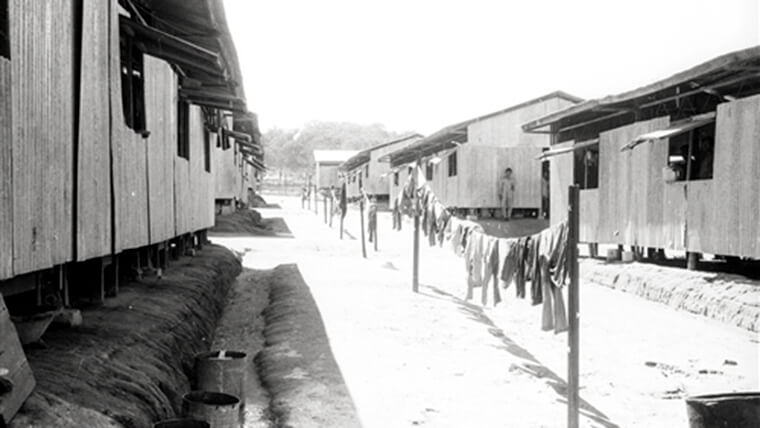
Phu Quoc prison real photos - Source: DE HAHN, BIERENS
The whole Phu Quoc coconut prison was covered by a fence made of several layers of barbed wire, a network of electric lines in the ceiling and alarming lights. Moreover, it was also integrated with watch towers regularly sat by armed guards. Each gate had a troop with submachine guns and rifles in hand.
The number of detainees in this period was about 6,000 people. By April, 1954, the quantity increased to 14,000 people, all of which were male. While being locked and tortured here, the soldiers bravely and restlessly fought and encouraged revolutionary campaigns of the Vietnamese. Also during this time, there were 200 prisons breaking the cage and 99 people died because of torments.
2 - Phu Quoc prison during the wars against American Empire
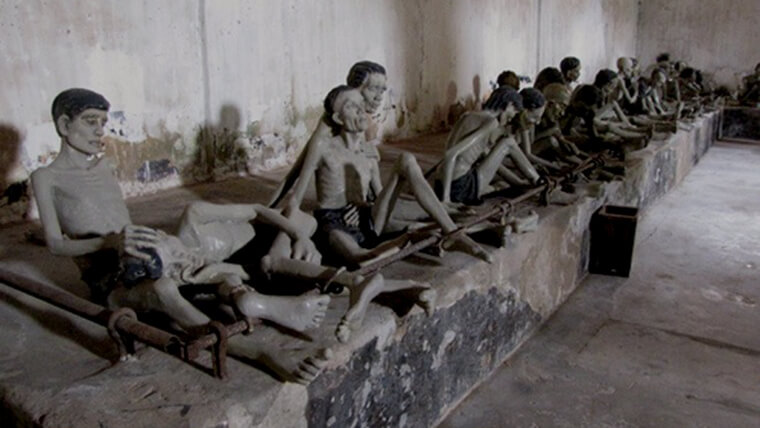
Source: condaoexplore
After the Geneva Agreement in 1954, the French handed over the prisoners and the management of the Coconut Tree prison to the government of the Republic of Vietnam, this detention entered a new chapter, more brutal and terrible. At the end of 1955, a new prison with an area of 4 hectares was built on the land of the old Coconut Tree prison. Different from the previous one, the Phu Quoc prison camp was classified into a camp for male, a camp for females and a camp for the elder, surrounded by 3 layers of barbed wire of 2.6 m high and 14 watch towers. After 7 months since it was put into service, the Phu Quoc prison witnessed a lot of getaways, especially the one with the participation of Mr.Pham Van Khoe (brother of Pham Hung, the second prime minister of the Socialist Republic of Vietnam) and Mr. Mai Thanh (Provincial Party Committee member, Secretary of Rach Gia town Party Committee).
In the face of this unrest, in 1957, the government of the Republic of Vietnam took the political prisoners in this confinement to the mainland, some to Con Dao prison. When the Vietnam Wars escalated, the number of prisoners rocketed, the Republic of Vietnam built more penitentiaries in different areas such as Bien Hoa province, Pleiku, Da Nang city, Can Tho city, Quy Nhon city,...
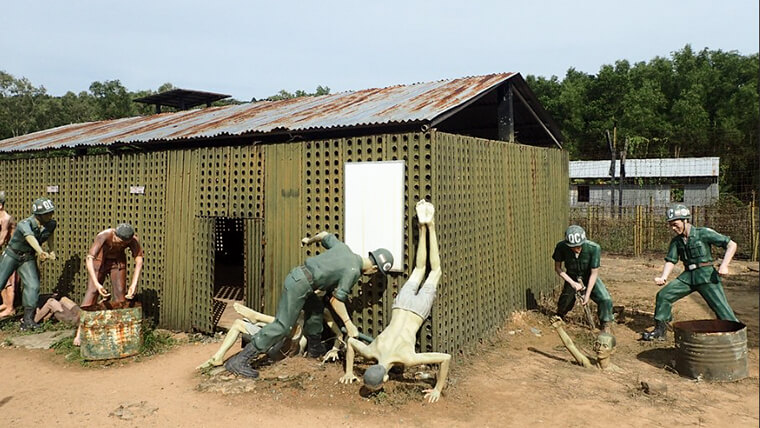
Phu Quoc prison torture - Source: vinwonders
In Phu Quoc particularly, they formed a detention camp of 400 hectare in An Thoi valley, about 2km from the old Phu Quoc jail and named it Phu Quoc Prisoners Of War Camp or Phu Quoc Communist Prisoners Camp.
Phu Quoc Prisoners of War Camp witnessed several evil punishments of which the most terrible were those initiated by jailer Bay Nhu. Under the rule of Bay Nhu, the detainees had to endure methods of torment which strongly stroke their iron willpower, leaded to irreversible wounds, namely chiseling tooth, smashing ankles, damaging eyes with light bulbs, soaking body in boiling water, removing fingernails, hammering nails into body,... Moreover, at this prison, there were torture areas such as Tiger Cages, high-voltage room, burial pits,...
II - Revealing the Phu Quoc prison relic
The Phu Quoc prison camp today is not the original construction but the result of restoration, modeling the torture area of the French colonial and American empire. Today, the remain only includes the following works:
1 - B2 Subdivision in Phu Quoc prison relic
The work with an area of 17,693 m2 restores facilities such as:
- Watch towers: allocated at 4 corners of the subdivision, made of steel, 5m high, 1.5m wide and tin roofed
- Fence: a system of 8 to 10 layers of barbed wires surrounding the construction
- Gate: covered with several layers of barbed wires, having security guards
- Barbed Wire Tiger Cages: lying tiger cages, sitting tiger cages, half low half high tiger cages, put outdoors, right on the ground, made of barbed wires, insides are models of prisoners.
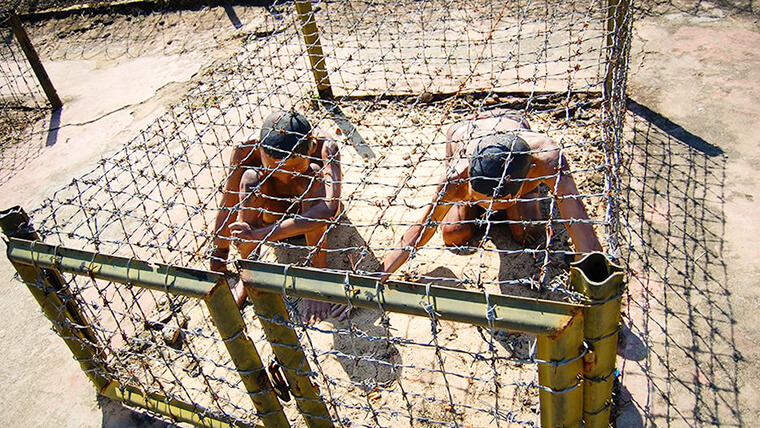
Phu Quoc Coconut prison tiger cage torture - Source: Internet
- Catso Tiger Cages - one of the the scariest form of torture at Phu Quoc prison small containers shaped by iron sheets covering 4 fronts. Those captured inside had no light to see, no air to breathe, after being released, both physical and mental health were significantly damaged.
- Kitchens and eating houses: located to the right of the gate, including 4 prefabricated houses (the frame is pre-assembled steel, the walls, roof and windows are made of tin or corrugated iron, having models of prisoners cooking.
- Cells: numbered from 1 to 18, the same type as the kitchens, embodying the scenes such as the daily life of prisoners, their protesting against jailers, hunger strike, bloody suppression, methods of torture, a tunnel that detainees dug to escape,...
- Solitary confinement room: size 9x3m, walls of the Solitary confinement room Phu Quoc prison made of steel sheets perforated with small holes, roof covered with canvas and a layer of barbed wires, a cemented floor in order to avoid prisoner digging tunnels. This place recreates the scenes when the enemy beated soldiers with mallets, spiked shoes or buried them alive,...
- Toilet: next to the fence behind the cells, modeling the scene invaders forcing Vietnamese prisoners to clean the floor, emptying waste bins,...
2 - Gallery of added monuments
The gallery was constructed with reinforced concrete, divided into 2 rooms, a cinema introducing briefly about Phu Quoc and an exhibition with 3 sections a (Section 1: physical model and the overview of the Phu Quoc prison (history and development, Section 2: methods of torture, and Section 3: forms of resistance and mementos). This is currently home to 43 artifacts, 100 documents, pictures & photos about the war and Phu Quoc jail.
3 - Monument to martyrs on a downy rose myrtle hill
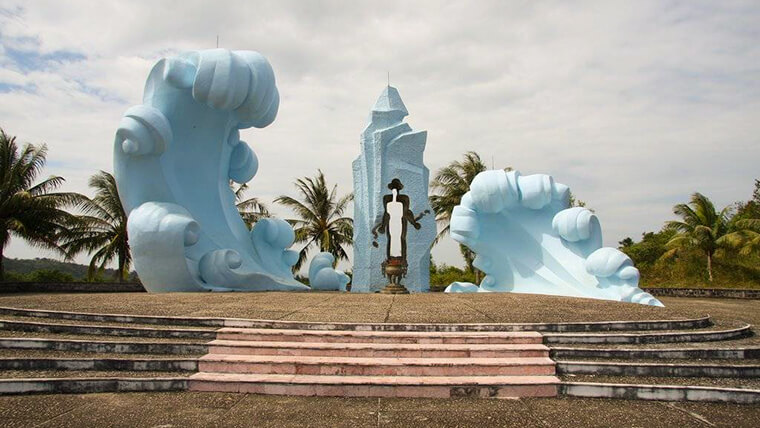
Monument - Source: phuquocsensetravel
The construction covers an area of 12,420.5m2, situated near residential area and Provincial Highway 47, with reinforced concrete as the main material. The memorial is designed with a wave-shaped symbol painted in blue, about 5m high on both sides and a pointed hollowed block of about 2m high, creating a humanoid implying “people who have gone from that place”.
4 - Cemetery of War Prisoners
Located about 1km from the B2 subdivision, this graveyard used to be the burial place of detainees who were killed at Phu Quoc coconut prison. After 1975, this place was extensively reconstructed with an area of 20,000 m2. The center of the cemetery has a circle-shaped design with a clenched fist shaped monument showing the hatred, resilience and indomitable, ready to sacrifice spirit of Vietnamese revolutionary soldiers.
5 - Kien Van church
Used to be a place for religious practice of the French and American officials at Phu Quoc prison, nowadays, the church is only a ruin. What remains are only cement pillars, floor and rubbles.
6 - Gate & houses of the prison Commanding Committee
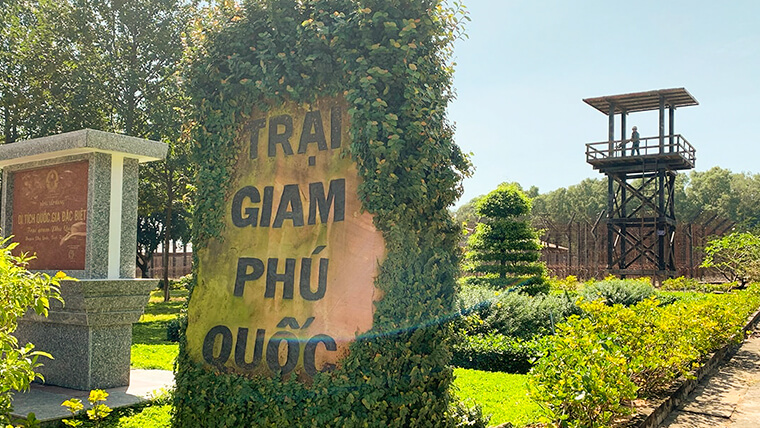
Phu Quoc camp relic - Source: phuot3mien
Both the gate and houses of the supervisors of Phu Quoc prison camp are products of restoration since the original structures broke down over the time. The 4 new houses have been rebuilt on the ground of the old buildings with brick walls, cemented floors, tin roofs, wooden windows and doors. The gate, however, has been relocated about 20 m from the first one. The main gate is made of strategic iron bars and barbed wire. Surrounding the gate and house of the Commanding Committee are fencing walls of which the front, bordering Provincial Highway 47, is made of barbed wire, while the others are built of concrete.
III - More information about Phu Quoc prison
- Address of the Phu Quoc prison: No.350 Nguyen Van Cu street, An Thoi commune, Phu Quoc city, 28 km away from Duong Dong town
- Ticket price: free
- Opening hour: 8 am - 11:30am and 1:30 pm - 5 pm
- Note:
+ Dressing politely
+ No touch on artifacts
+ Bringing water and snacks because you can hardly find any department stores to buy in the campus.
+ No littering, protecting the environment
Although Phu Quoc prison has witnessed a lot of pain and loss of Vietnam in the struggle against tortures and ssuppression of the colonialists and imperialists, it is also the place where the fire of the revolution was lit up, where the willpower, indomitable spirit of Vietnamese revolutionary soldiers were fostered. If you have the opportunity to travel to Phu Quoc, don't forget to visit this place to express your honor to those who bravely fought for the peace of a nation.







.jpg) — Ha Bich
— Ha Bich







